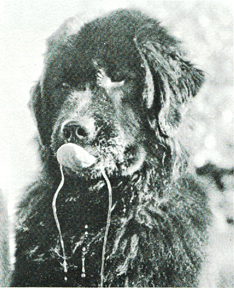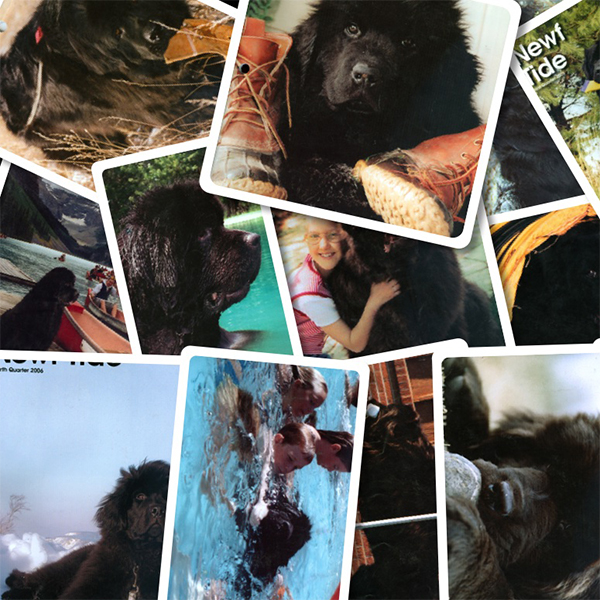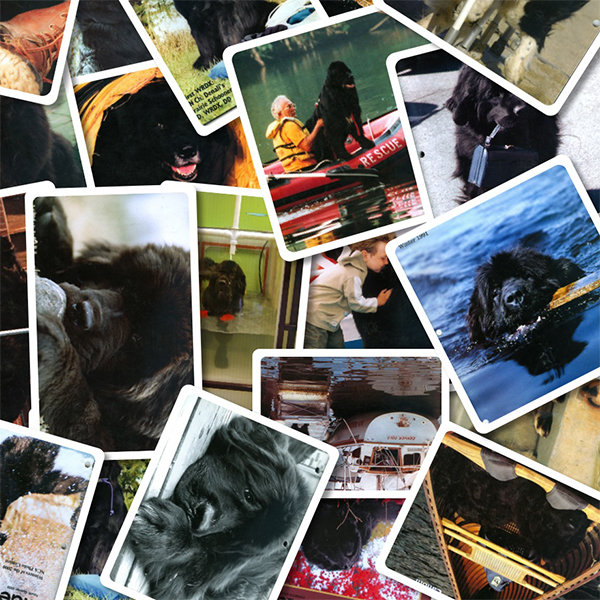by Judi Adler
A tongue-in-cheek look at the Newfoundland

Recently, the revised standard for the Newfoundland breed was released to the fancy. Years of study were behind its changes. Color, topline, bite, movement. and temperament were all covered in detail. Yet there is one glaring omission in both the old and the revised standard. nowhere is there mention of salivary activity. Surely something as prevalent within the breed as saliva production should rate a sentence in the standard! Since the subject of drooling is not covered in any written text, the following treatise is offered as one step in the right direction.
It's important to be aware that the amount of saliva a Newf will produce is not entirely predictable. Genetically, one might feel that an extremely wet-mouthed sire and an equally gooey dam would produce puppies with lavish liquid flow. Mother Nature often plays perverse tricks and produces dry mouthed puppies from such a combination, so if spit production is essential to you, it's wisest to bring home an older dog whose capacities are well documented.
Should you opt for a young puppy and take your chances, you'll find that puppies at six or eight weeks are deceptively (if temporarily) dry-mouthed. Production of saliva takes time and maturity, and some frustrated owners have almost given up hope, when finally at six or twelve months that first tiny trickle of drool appears.
An old wives' tale has it that you can predict saliva output by the tightness or laxity of a Newt's lips: a dog with loose flews will produce more spittle than a dog with taut flews. This is incorrect. A dog with loose flews allows a continual small drip, drip, drip that is almost unnoticed, while a dog with tight lips has a perfect leak-proof receptacle to store the saliva until he's got the proper quantity to produce a pair of truly magnificent spit-strings.
Of course, Newfoundlands aren't the only breed that drools. Should saliva be important to you, there are breeds that are more wet-mouthed than the Newfoundland. However, for sheer dramatic impact, there is nothing to compare with a sparkling spit string set against a jet-black coat. A slavering Saint or Pyrenees pales in comparison.
If you enjoy grooming, it's best to select a very wet-mouthed Newf, as that drool makes the loveliest collection of mats on the dog's chest. Truly a challenge to any groomer. Luckily, it's a continual process, for no sooner do you have that chest coat all combed out than an hour later the spit has it all matted up again.
The excitement of travel often brings out the best in salivary activity. If your Newf rides in the back seat, the gas station attendant will smile knowingly at the opaque side windows and won't even offer to wash them, knowing the streaks are all on the inside. When driving, you'll find your Newf with his muzzle planted firmly on your shoulder, and as he adoringly nuzzles your ear, his saliva is running across your shoulder and down your back and arm, providing visible evidence of his affection for you.
Wet-mouthed Newfoundlands are beneficial in other ways. If you lust for public recognition, try putting a bib on your Newf. There are custom-made bibs especially for Newfs, or you can design your own. The cardinal rule is the brighter the color, the more attention you'll attract. Scarlet, chartreuse, and shocking pink are good bib colors. It is an incontestable fact that if you enter your Newf in a dog show and walk him around in his monogrammed scarlet bib, the newspaper photographers and television cameramen will flock around, and you'll find the lead story the next day won't have a photo of the Best in Show Whippet or L’hasa, but of your bibbed friend. It's true! Even at the 198O National Specialty in Sacramento, the local newspaper write-up showed a huge photo of a female Newf and her two young sons, all in matching bibs. The TV reporting was even more laudatory to damp Newfoundlands. The sixty-second feature consisted primarily of film of the above-mentioned trio, and the closing segment was a headshot of a magnificent frothy Newfoundland with a fine collection of spittle slowly gliding down his neck and chest.
Don't be misled into thinking that all Newfs drool equally. Should someone try to convince you his prize Newf is suitably wet mouthed, and you are in doubt as to the truth, there are subtle ways you can check. Observe the owner's attire. If he's wearing permanent press, polyester dress slacks, that's a bad sign, whereas an owner in well-worn Levis jeans is far more encouraging. Observe the Newf owner's home. Are there small terrycloth towels hanging from the refrigerator handle, flung over each chair arm, and wrapped around every doorknob? Look very closely at the kitchen walls and ceiling. A truly wet Newf will shake his head violently to empty his collection of spit (for after all. it's the one renewable resource: there's plenty more where that came from!). Spit is very adhesive, and the globs that go flying usually stick to ceilings, windows, walls, and kitchen cupboards. Don't look for these telltale signs on the owner, however an experienced owner learns early in the game that fast reflexes are essential and with constant practice can easily duck any flying globs of saliva. In fact, a truly experienced owner can gently remove a well-developed spit-string from his dog's mouth, carefully transferring it on one finger, and then manually flick it in whatever direction is desired.
Drool comes in many forms. Just as no two Newfs are alike, so are the kinds of saliva varied. Some Newfs produce very little, just puny inch-long strings that are immediately flung off into the air. Other more patient dogs can sit motionless until the spit-strings descend from mouth to floor before breaking off. Some strings are crystal clear: others contain air bubbles and have a frothy texture. Should you hike in the woods with your dog, you'll find bits of leaves and grass stuck to the spit-strings. Those Newfs lucky enough to live by the ocean can create masterpieces of sand and saliva that resemble miniature stalactites.
Dogs employ many techniques to remove their accumulation of spit. If a Newf comes up to you and gently places his head in your lap, don't be deceived into thinking he loves you. He's just used Technique III-A for removing the spittle, for it's no longer on his face but all over the front of your pants. Some Newfs take great pleasure in storing it up until a long string results, and then casually shake their heads sideways. If done properly, the spit-string won't break off but will wrap itself cleanly around the dog's muzzle. Depending on the length of the string and the skill of the dog, it can loop around once or even twice. Occasionally you'll meet a truly masterful Newf who can fling his spit at exactly the right velocity, height and direction so it unerringly lands in your fresh cup of coffee.
Don't make the novice's mistake and think that drool is undesirable. One visit to an AKC conformation show will dispel that notion. Observe the top Newfoundland handlers in action. Notice how each one has a large, brightly colored ring towel hanging half out of his or her pocket. Each step the handler takes causes that towel to wave in the breeze, and when the handler stops, he whips out the towel with a flourish, lavishly swiping at his dog's mouth. This maneuver cleverly draws attention to the amount of drool his majestic dog produces.
One should never underestimate the value of a dog that drools. Studies have shown that a wet-mouthed dog is easier to train for obedience, and will earn titles more quickly than a dry-mouthed dog. If you train for your CD, CDX or UD indoors, that wet mouth is a great training help. On the novice or open long sit exercise or the utility long stand, a wet Newf will leave a perfect puddle of spit drops on the concrete floor, and by the position of those drops in relation to his body you can tell immediately if he's shifted position (a no-no) and can correct him to exactly the spot where you left him. But the biggest advantage you have in earning a title is during the novice or utility stand for exam exercise, for a dog who drools copiously is certain to have a much more cursory examination by the judge than a dog who is dry. A novice handler might worry that his dog might not drool during this exercise. Many handlers tried to carry food into the ring just to get their dogs drooling, so the rules now forbid food in the ring. This is no cause for alarm, however, for there's always a spectator at ringside that says, "Oh, what a nice big dog-can I feed him a cookie?" and that'll start him off.
Should you find yourself saddled with a Newfoundland who does not drool, don't despair. There are several ways to bring out the flow in an otherwise nice dog:
1. With your Newf in a sit/stay, stand directly in front facing him and slowly eat a fried chicken leg.
2. Put on your special, designer label, "dry clean only" white linen suit. There's something magnetic about white clothes that causes even the driest of Newfoundlands to set his juices flowing.
3. Put a large bucket of water in the kitchen and allow your dog to drink from it for a day or two without changing the water.
There's a chemical equation for the reaction that occurs: K9 + H20 = Drool. Put simply, the dog, by immersing his muzzle into the bucket of water, causes the water to undergo a colloidal process. End result; the water becomes coated with a thick layer of viscous goo that resembles Karo corn syrup. Even a dry-mouthed Newf will find the Karo syrup-like fluid sticking to his muzzle and dripping in long, sticky strings. It is impossible for anyone to tell the difference between the classic natural spit-string and an artificial, bucket-induced syrupy one.
4. If all else fails, invite your most elegant. prissy, immaculate relative (your Great-Aunt Edna, perhaps) over for cocktails. Such a paragon of fastidiousness is rightly perceived as a challenge by even the driest of Newfs, and within seconds of meeting her, his saliva will be off and running, usually down Great-Aunt Edna's silk cocktail dress!
reprinted from NewfTide 1980

